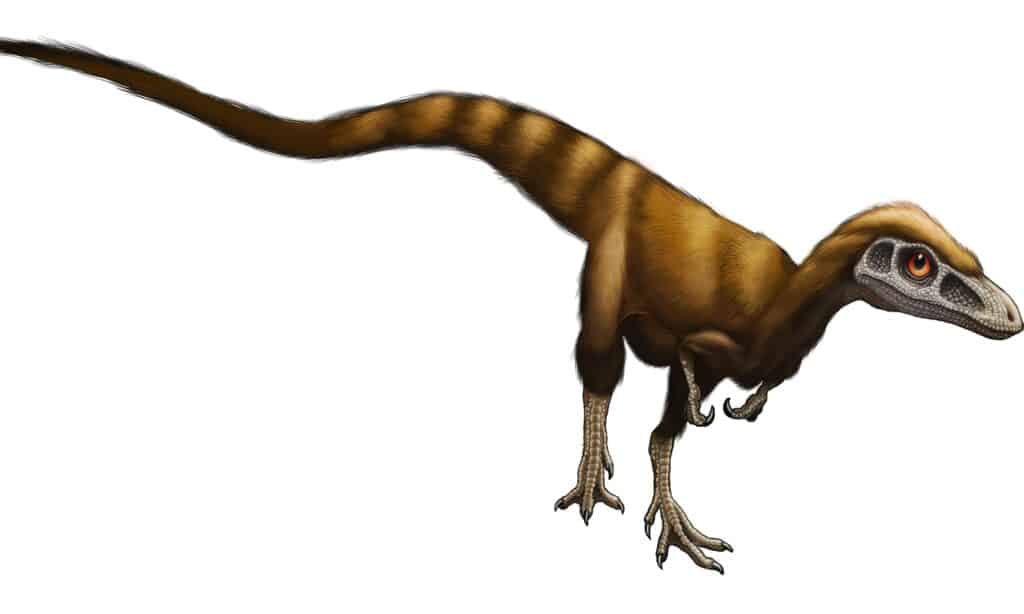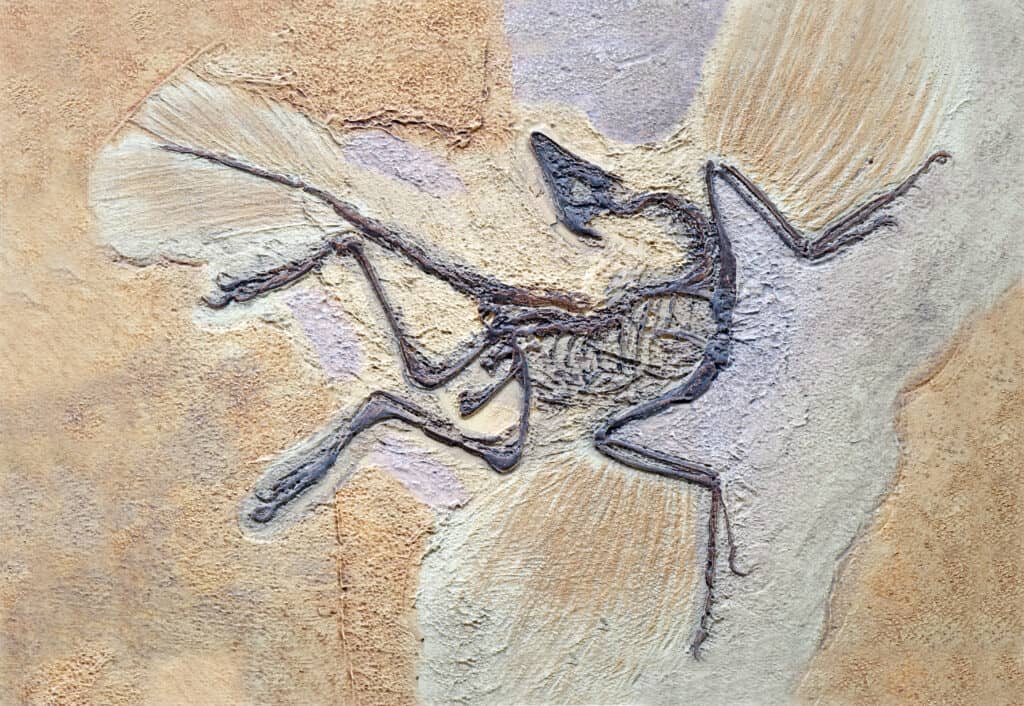During the summer of 1996 in Sihetun, a Chinese farmer named Li Yumin came across the fossil of a dinosaur that roamed the earth 124.6 to 122 million years ago. This was the Sinosauropteryx, a feathered dinosaur that had an unusually orange coloration. This dinosaur walked the earth millions of years before our time and lived during the Cretaceous Period. At the time of its existence, the Sinosauropteryx lived in what we now know as China.
The discovery of the Sinosauropteryx had scientists in an uproar, as it could provide a new lead as to whether dinosaurs evolved from birds. The discovery of the Sinosauropteryx is fascinating because their feather structures were so well preserved that scientists were able to determine the color of their feathers, which makes them one of the first non-avian but feathered dinosaurs ever discovered. So let’s learn about the orange, feathered, ring-tailed meat eater!
Discovery of the Sinosauropteryx

Pictured, a replica of the Sinosauropteryx located in Seodaemun Museum of Natural History in Seoul, South Korea.
©Danny Ye/Shutterstock.com
Li Yumin is a Chinese farmer that was the first to discover the existence of the Sinosauropteryx in August 1996, in Sihetun, Liaoning Province in China. This was an important discovery of a non-avian dinosaur that had the color of its feathers preserved. This discovery led scientists being able to know more about the colors dinosaurs may have been. This also gave scientists more insight into the link between birds and dinosaurs and how they have evolved over millions of years.
Yumin was a part-time fossil hunter too and he would look for the remains of fossils that he could sell to museums and individuals that would be interested in his discoveries. Yumin knew that the specimen he had found was special, so he sold two slabs where the fossil was to two museums in China, including the National Geological Museum in Beijing and the Nanjing Institute of Geology and Palaeontology.
The director of the Beijing museum, Ji Qiang, found that the find was significant, along with a Canadian paleontologist named Phil Currie and an artist named Michael Skrepnick. They came across the fossil remains after a visit to the Beijing museum. Phil Currie knew the importance of the fossil right away, and he exclaimed that he was “bowled over” when he saw the slab of siltstone that was mixed with volcanic ash where the creature was embedded.
At first, Chinese authorities prohibited any photos of the specimen being taken and published, but Currie ended up bringing a photograph with him to the 1996 conference in New York. This caused a gathering of paleontologists to discuss this phenomenal discovery. Eventually, the news traveled to paleontologist John Ostrom, who was the first person to hypothesize that dinosaurs could have evolved from birds, and John was in a state of shock at the holotype Sinosauropteryx specimen.
John then met with a group of expert scientists to look at the fossils in the Beijing museum. The three specimens that were discovered have been paced as a Holotype GMV 2123 to Sinosauropteryx prima.
Each of the juvenile Sinosauropteryx specimens was found in the Jianshangou or Dawangzhangzi beds of the Yixian Formation in the Beipiao and Lyngyuan regions of Liaoning in China. These fossil beds are millions of years old, which indicated to scientists that the Sinosauropteryx was alive during the middle Aptian phase during the Early Cretaceous Period, roughly 124.6 to 122 million years ago.
About the Sinosauropteryx

The Sinosauropteryx was covered in reddish-orange feathers.
©Bee_acg/Shutterstock.com
Now, the Sinosauropteryx was not your average dinosaur. The fossil was found with filament-like feather structures and a preserved coloration in the feathers. They were non-avian dinosaurs with a coloration that consisted of a reddish-orange color and a ringed brown tail.
The Sinosauropteryx was a small bipedal theropod that had very short arms and an abnormally long tail. They grew to around 3.51 feet in length and only weight up to 1.21 pounds, as heavy as a brick. So far only three specimens have been discovered, and one has been named S. prima. They lived during the early Cretaceous Period in China and were one of the first well-preserved fossils that allowed scientists to learn more about its biologies such as reproduction and diet.
These dinosaurs were carnivores that hunted for meat and had speed and agility thanks to their long tail which they used for balance to climb trees and rocks with ease. Some of the fossils showed evidence of an alternating pattern of light and dark brown bands along the tail, and the fossilized feathers contained preserved melanosome cells which gave the feathers their color.
Due to the Sinosauropteryx’s small size and carnivorous nature, they likely only ate small mammals and lizards because they were not capable of taking down larger prey. This is supported by the fact that the specimen of the Sinosauropteryx had a small mammal in its stomach, but paleontologists were unable to identify which mammal it had eaten before its death.
The Evidence Of Feathers
The Sinosauropteryx was the first fossil to be discovered with colored feathers. The feathers contained a color pigment of a russet-orange color and the darker regions of the tail contained phaeomalnosomes. This helped give scientists to first clues as to what colors dinosaurs could have had.
The filaments of the feathers were a type of feather that was preserved along the back of the skull, down to the dinosaurs’ arms, neck, back, and all the way to its long tail. Some feathers have also been identified on the side of the Sinosauropteryx’s body, which indicates that they were likely fully feathered at their time of existence.
Since the named specimen of the Sinosauropteryx was only a developing juvenile, these feathers could have still been developing and would possibly change as it reached adulthood. The feathers started short along the top half of the body and increased in length further down to around 0.51 inches near its shoulder blades.
The Scientists Tests

Evidence of feathers were found on the fossilized remains of Sinosauropteryx
©Mark Brandon/Shutterstock.com
A team of scientists found two types of melanosomes within the fossil’s structure, known as eumelandosomes such as the ones found in zebras, and the phaeomelanosomes that store red pigment in red human hair and even red-tailed hawks. The scientists didn’t find any structures that would give the Sinosauropteryx a yellow or blue color, but this could be because those pigments degrade much quicker than others.
The Sinosauropteryx could have also had white mixed in with the colors, but this would also have degraded quicker. This has made the Sinosauropteryx one of the most colorful feathered dinosaur species. Even though the small bristly feathers on the Sinosauropteryx were not used for flight, they could have been used as a form of insulation.
Even though we describe the filaments as feathers, the thick filaments did not have any evidence of calcium phosphate, which is what feather quills are currently made of. This is also supported by the curve of the filaments, which makes it likely that they lacked a strong central quill.
It is hypothesized that the feathers of the Sinosauropteryx are merely single-branched filaments that have been joined at the base which created a tuft-like appearance, like down-like plumaceous feathers. The feathers of the Sinosauropteryx were soft and framed its body from head to toe with a russet-orange and brown banded coloration.
Up Next
- Meet The First Dinosaurs To Be Discovered
- Meet The First Dinosaur With Feathers To Be Discovered
- Top 10 World’s Largest Dinosaurs Ever
The photo featured at the top of this post is © Bee_acg/Shutterstock.com
Sources
- Dinosaur Encyclopaedia , Available here: https://dinosaurencyclopedia.org/sinosauropteryx/
- Wikipedia , Available here: https://en.wikipedia.org/wiki/Sinosauropteryx
- Nature , Available here: https://www.nature.com/articles/news.2010.39#:~:text=Fossils%20of%20one%20theropod%20dinosaur%2C%20Sinosauropteryx%2C%20reveal%20that,with%20phaeomelanosomes%2C%20indicating%20they%20were%20russet-orange%20in%20colour.
Thank you for reading! Have some feedback for us? Contact the AZ Animals editorial team.






